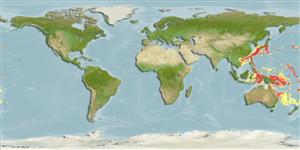Teleostei (teleosts) >
Alepocephaliformes (Slickheads and tubeshoulders.) >
Alepocephalidae (Slickheads)
Etymology: Xenodermichthys: Greek, xenos = strange + Greek, derma = skin + Greek, ichthys = fish (Ref. 45335).
More on author: Günther.
Environment: milieu / climate zone / depth range / distribution range
Ecology
Marine; benthopelagic. Tropical
Western Pacific: Japan and the Philippines.
Size / Weight / Age
Maturity: Lm ? range ? - ? cm
Max length : 20.0 cm SL male/unsexed; (Ref. 559)
Dorsal spines (total): 0; Dorsal soft rays (total): 32 - 33; Anal spines: 0; Anal soft rays: 32 - 33. Head and body covered with filmy skin. Scales absent form the body. Head small; eyes large and circular. Dorsal fin opposite to anal fin. Bases of median fins long. Photopores very small projecting from skin with the peduncle. Body color brown.
Life cycle and mating behavior
Maturity | Reproduction | Spawning | Eggs | Fecundity | Larvae
Masuda, H., K. Amaoka, C. Araga, T. Uyeno and T. Yoshino, 1984. The fishes of the Japanese Archipelago. Vol. 1. Tokai University Press, Tokyo, Japan. 437 p. (text). (Ref. 559)
IUCN Red List Status (Ref. 130435: Version 2024-1)
Threat to humans
Harmless
Human uses
Tools
Special reports
Download XML
Internet sources
Estimates based on models
Preferred temperature (Ref.
123201): 4.1 - 10.3, mean 6 °C (based on 386 cells).
Phylogenetic diversity index (Ref.
82804): PD
50 = 0.7500 [Uniqueness, from 0.5 = low to 2.0 = high].
Bayesian length-weight: a=0.00347 (0.00163 - 0.00737), b=3.19 (3.00 - 3.38), in cm total length, based on LWR estimates for this (Sub)family-body shape (Ref.
93245).
Trophic level (Ref.
69278): 3.4 ±0.5 se; based on size and trophs of closest relatives
Resilience (Ref.
120179): Medium, minimum population doubling time 1.4 - 4.4 years (Preliminary K or Fecundity.).
Fishing Vulnerability (Ref.
59153): Low vulnerability (14 of 100).
